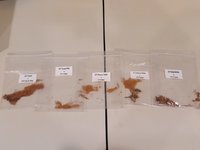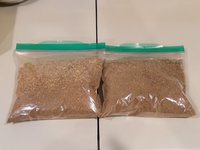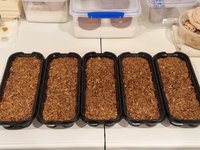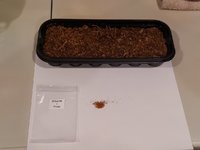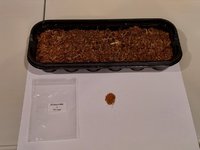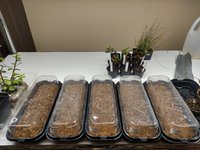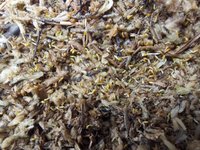Do you know which of the parents was SP & PP? I'm wondering if my cross was the same.
Yeah, your cross is the same.
I'm planning to cross 'Daiseko' x 'Chojuho' both ways this year. I am hoping 'Daiseko' will introduce the multicolored flower gene and 'Chojuho' the flower size into the F1 generation.
Then I will cross F1 to make F2....hopefully one of those offspring will be the ticket holder. Both have pointed petals so it should be interesting
With the Chojuho flowers you kind of have to plan for an F2. But in general, I think it is best to make crosses where you believe the F1 generation already will be promising.
'Renee Michelle' has some really nice flowers, but they are very large. I think it would be a good fit for larger bonsai. But you are correct it fits perfect as a landscape plant. 'Elsie Lee' also has some very pretty flowers. If I can get pollen I will try some crosses with 'Elsie Lee' as well.
Many people did many crosses with 'Elsie Lee'. One of the upsides is that apparently, 'Elsie Lee' produces a ton of seeds.
My plan is to cross the offspring from the two separate crosses I did of the same parents. Maybe something will come out of it?
I don't quite get what you mean? Do you mean cross Pleasant White (SP) x Chojuho (PP) with Chojuho (SP) x Pleasant White (PP).
Any cross can work. However, any seedling you produce yourself only is as good as the selection criteria you put on it. Or in other words, as good as the inferior seedlings you discarded from a specific cross to get that one superior one. With named varieties, this is already done. Say 'Renee Michelle' was the individual with the best pink colour. If you cross Renee Michelle (SP) x Chojuho (PP) seedlings that are average, you may dilute this 'special type of pink'-trait that 'Renee Michelle' has, reducing the likelihood of a pleasant pink colour in the F2 generation. Same can be true for other traits.
Therefore, if your goal is producing small multicoloured flowers, it is much better to get the right parents then to try to cross your F1 into F2 and possibly F3. In the end, that will also work. But it takes more time (and space). Of course, for Chojuho, you kind of have to do this, because there is only Chojuho and Senbazuru.
I'm wondering if I can get pollen from 'Sachsenstern' all the flowers if gave last year had no pollen. I remember you mention the red border won't be passed down, correct? But I can say 'Sachsenstern' foliage looks the nicest of all the azaleas I have. It's a nice size and shape. The color is also a nice dark green.
It may be the case that the border won't inherit. The Belgian indica researchers have some papers out where they found that flowers with coloured borders on a white flower, or white borders on a coloured flower have different ploidity levels. So that the 2n tissue is white, and the n4 tissue is coloured (or the other way around).
They state quite empathically that they therefore believe that jewel border/fukurin type flowers only emerge as (rare) sports on solid coulred flowers.
However, I talked to some breeders and they got jewel border patterns on seedlings.
The same discussion is there with white centers. Now, we do not know if Sachsenstern is an extreme version of a white center (say like Shinnyo no Tsuki). Or if it is some different mechanism.
I myself have a seedling that is slowly getting the white centers. Neither parents had white centers.
I made crosses of jewel border varieties (Encore Sunburst and Surprise), and I can see the seedlings have both green and reddish stems. I crossed the jewel border azaleas with white sporting azaleas.
So it seems the jewel border azaleas act as heterozygous for colour. The red stemmed seedlings may turn into solid pinks and reds, possibly with white centers. And the green stemmed seedlings into white, white with variegation, jewel border, or very pale colours.
If I had to place a bet right now, I would say that Sachsenstern likely acts the same as a jewel border variety. And that the offspring can be variable.
But the Belgian scientists seem to think differently. It is not unthinkable that the same flower patterns in Belgian indica originate from a different mechanism when compared to say satsuki.
If you like it, I would say go for it.
I think space will be my biggest issue. There will be a lot of plants to grow out for years. This time I do plan to transplant them early along with moving them outside as soon as I can.
I was more referring to short term space. If you have some more of those trays, and space in your growing station shelf, you will give the seedlings that you transplant as I suggested a large growth boost.
I have overcrowded trays. And seedlings I transplanted a few months ago from those overcrowded trays. The transplanted seedlings are maybe double the size.
I am actually surprised that the presence of nearby seedlings can limit growth. It almost suggest they can feel the presence of the seedlings alongside, driving them into elongated stem growth, limiting their photosynthetic surface area, and thus total size.
If you can pick up a Kobai from White's, that one will serve you well. My Kobai plants both produce seeds very well. Hekisui(Aozora) is one of my favourite. It has smaller leaves than Kozan and they are always neatly placed. But the fertility on that one is low.
I can double check the stem colour on my Kobai seedlings from this year. I forgot if they are a mix or green and reddish.
Kobai x Kakuo would be an excellent cross.
I can also see if I can send you some cuttings of small flowering multicoloured satsuki. But that may be due for 2023, meaning they will maybe first flower in 2025.
By which time your first seedlings will likely flower as you can make the cross with those cuttings.
